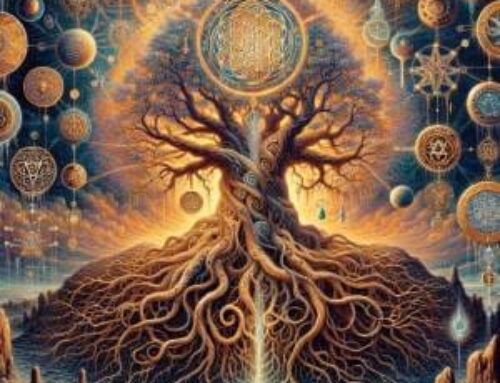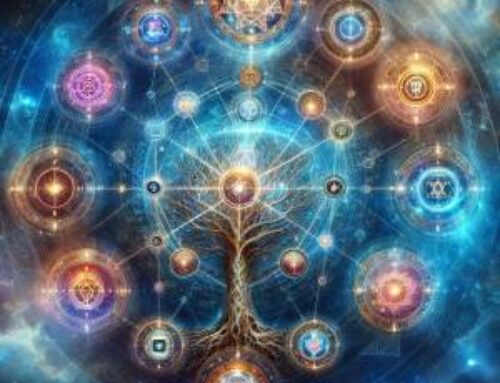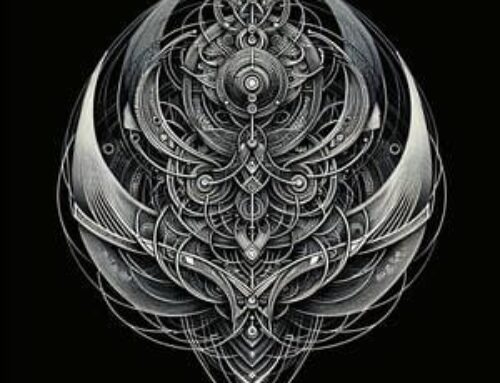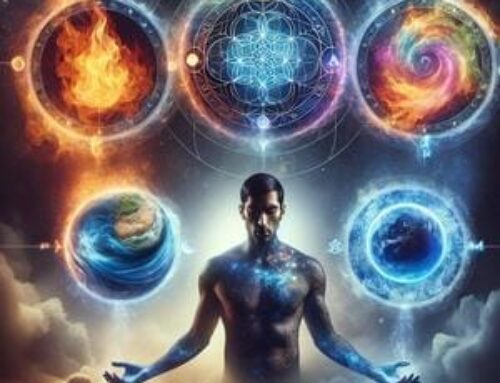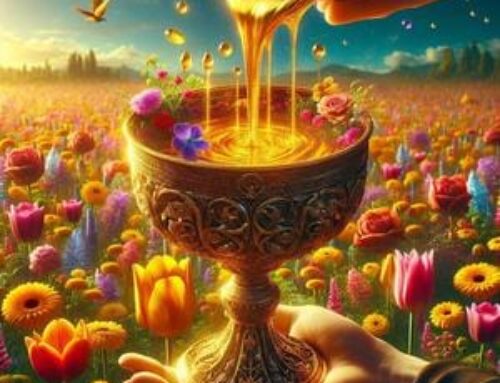Contents
Alchemy—shrouded in mystery and tradition—often finds itself labeled as ancient magic. This practice, with its roots deeply intertwined in both spiritual and material realms, aims not only to transform physical substances but also the practitioner’s soul. This article dives into how alchemy transcends the conventional boundaries of science, touching the realms of magic through its unique principles and practices.
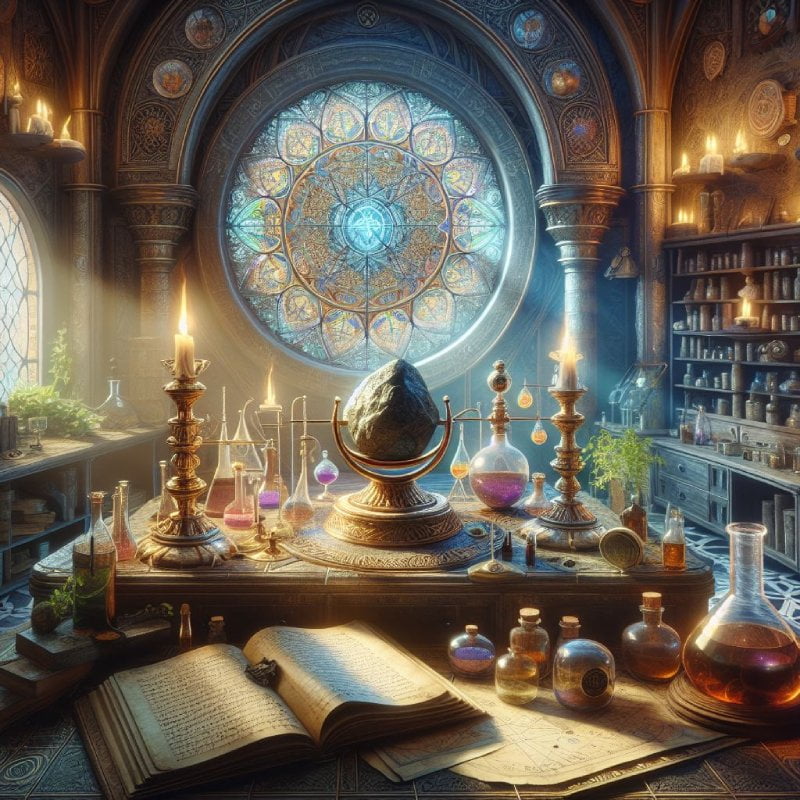
Alchemy: A Convergence of Science and Magic
More than an archaic science, alchemy represents a profound spiritual journey, seamlessly combining the material and mystical aspects of the universe.
Spiritual journeying is a lifelong process that involves exploring one’s inner self and a larger cosmic consciousness, often leading to transformational experiences and assisting others in healing processes (1).
Historically, alchemists straddled the roles of scientists and magicians, working in secrecy to unlock nature’s deepest mysteries. The term “alchemy” itself, derived from the Arabic “al-kīmiyā,” signifies the art of transformation. This transformation extends beyond converting base metals into gold, encompassing the spiritual elevation of the alchemist. In Hermetic traditions, alchemy is seen as a sacred science, unveiling divine principles that govern the cosmos. This blend of the spiritual and material realms makes alchemy akin to magic, revealing hidden connections and harnessing subtle natural forces for profound change.
The Esoteric Essence of the Alchemists
Alchemy is inherently esoteric, with its true meanings and methods accessible only to the initiated (2). This secrecy serves not to exclude but to protect profound truths from misuse. Alchemical texts are rich in symbolic language, metaphors, and coded messages that only the enlightened can decipher. This esoteric knowledge encompasses the Tria Prima (Sulphur, Mercury, and Salt), the Four Elements (Earth, Air, Water, Fire), and the mystical process of the Great Work. These components represent both physical substances and spiritual principles, illustrating the dual nature of alchemical magic. For instance, transforming lead into gold metaphorically signifies personal enlightenment and spiritual purification, indicating that alchemy is a path of inner and outer transformation.
The Dual Nature of Substances
- Sulphur, Mercury, and Salt: These elements symbolize spirit, soul, and body beyond their physical forms.
- Four Elements: Earth, Air, Water, and Fire serve as both material substances and spiritual essences.
Symbolic Language and Secrecy
- Intentionally Obscure Texts: Alchemical writings are deliberately cryptic to safeguard sacred knowledge.
- Use of Symbols and Metaphors: Conveying deeper spiritual truths through complex symbolism.
The Path to Spiritual Enlightenment
Alchemy is fundamentally a spiritual discipline, often described as a path to enlightenment akin to mystical quests in various religious traditions. The alchemical journey involves stages such as Nigredo (blackening), Albedo (whitening), and Rubedo (reddening), symbolizing the soul’s death, purification, and rebirth. Through meditation, ritual, and disciplined application of alchemical principles, practitioners aim to achieve the Philosopher’s Stone, a legendary substance said to grant immortality and ultimate wisdom. This quest reflects the universal pursuit of self-improvement and divine understanding. Ultimately, alchemy strives to harmonize the alchemist’s soul with the divine order, achieving spiritual perfection and unity with the cosmos.
Stages of Transformation
- Nigredo: The stage of dissolution and breaking down impurities.
- Albedo: The purification and enlightenment of the soul.
- Rubedo: The final stage of integration and perfection.
The Philosopher’s Stone
- Ultimate Achievement: Symbolizes immortality and divine wisdom.
- Representation: The perfected soul and enlightenment.
Interweaving Science and Spirituality
Reflecting on the historical significance of alchemy, we witness a complex interplay of scientific inquiry and mystical belief. Alchemists contributed to the evolution of modern chemistry while pursuing metaphysical truths. This dual pursuit underscores alchemy’s unique position in the history of human thought. The practice offers a perspective that melds scientific exploration with spiritual questing, revealing the interconnectedness of all things.
The Alchemical Legacy
The legacy of alchemy is enshrined in Hermetic wisdom, representing a divine science and mystical tradition. It continues to inspire seekers of truth and wisdom. Alchemy’s journey of inner transformation leads to revelations of the cosmos’s hidden truths. Its enduring charm lies in its blend of science, spirituality, and magic, offering insights into the universe’s interconnectedness and the potential for profound transformation (3). Alchemy captivates and inspires, inviting exploration into the material and mystical depths.
Alchemy’s blend of scientific, spiritual, and magical elements offers a unique perspective on the universe. It reveals the interconnectedness of all things and the possibility of profound transformation. Whether viewed as a historical curiosity or a spiritual path, alchemy continues to captivate and inspire, inviting us to explore the depths of both the material and the mystical.
The Role of Symbols and Rituals in Alchemy
Symbols and rituals, dear reader, are not mere accessories in alchemical practice—they are its very heart and soul. They serve as portals, tools to access and manipulate the universe’s subtle energies. Consider the ouroboros: a serpent devouring its own tail, an image etched into the alchemist’s mind as a symbol of the eternal cycle of destruction and creation. Or the philosopher’s egg, embodying the alchemical vessel and the genesis of creation. These symbols provide a visual and conceptual scaffold for the transformative journey ahead.
And rituals? Ah, they are the lifeblood, the practical enactment of these symbols and theories. By performing rituals, alchemists focus the mind, purify the spirit, and attune themselves to both natural and divine forces. Picture the athanor, that special furnace used for controlled heating and transformation, a tangible focal point of the ritual process. Consider the prima materia, the primordial substance believed to be the genesis of all matter. Through these acts, alchemists assert their influence over both the material and spiritual realms, seeking the miraculous transformations alchemy promises.
Higher states of consciousness and meditation enhance the process of thinking by adjusting to the demands of a situation, with learning establishing instability mechanisms and meditation promoting stability (4).
The Symbols of the Alchemists
Ouroboros: A vivid image of perpetual destruction and rebirth. It’s not merely a snake eating its tail—it’s a profound representation of the cycle of life and death. Philosopher’s Egg: This isn’t just an egg; it’s a microcosm, an emblem of the alchemical process of creation and transformation.
Ritual Practices
The Athanor: This isn’t just any furnace; it’s the crucible of transformation, where the alchemist’s will meets the raw materials of nature. Prima Materia: More than a mere substance, it’s the elusive, fundamental essence from which all matter derives.
In the grand tapestry of alchemy, these symbols and rituals weave a narrative that transcends mere chemistry. They invite the practitioner into a dance of science, philosophy, and magic. It’s not just about transforming lead into gold, but about the alchemist’s own spiritual metamorphosis.
The Alchemist’s Path
Alchemy, in its true essence, is a profound synthesis. It’s an intricate blend of esoteric knowledge, spiritual discipline, and symbolic ritual. By mastering alchemical principles, practitioners seek to transform not just matter, but the very fabric of their spiritual existence.
Curious souls can delve deeper into these mystical traditions at the Hermetic Academy. This institution offers a treasure trove of resources and teachings that explore the hidden depths of alchemy and the Western Mystery Tradition. Embrace this journey, and you might just discover the magic within yourself through the ancient art of alchemy.
FAQ- Alchemy is magic
1. What is the essence of alchemy in relation to magic?
A: It straddles the line between science and magic, transforming substances and the spirit through esoteric knowledge and mystical practices.
2. How does alchemy differ from modern science?
A: Modern science is grounded in empirical evidence and physical laws. Alchemy, however, marries spiritual philosophy with experimental processes, aiming for holistic transformation—both material and spiritual.
3. What are the main stages of the alchemical process?
A: The alchemical journey involves several stages: Nigredo (blackening), Albedo (whitening), and Rubedo (reddening), each symbolizing phases of dissolution, purification, and ultimate perfection.
4. How do symbols play a role in alchemy?
A: Symbols are the language of alchemy. They convey profound spiritual truths and guide practitioners through the transformative process, appearing in texts and rituals to encapsulate various principles and stages.
5. Where can one study more about alchemy and its practices?
A: For those eager to explore, the Hermetic Academy offers extensive resources and teachings on alchemical wisdom and the Western Mystery Tradition, paving the way for a deeper understanding and practical application of alchemical principles.
Embrace the alchemical journey. Unveil the magic within.
References
(1) Keegan, L. (1991). Spiritual Journeying. Journal of Holistic Nursing, 9, 14 – 3. https://doi.org/10.1177/089801019100900103.
(2) Rubenstein, E. (2023). Alchemy: Secrets of Consciousness Transformation. Hermetic World, Paphos.
(3) Rubenstein, E. (2023). Magic: The Legacy of the Rosicrucians. Hermetic World, Paphos.
(4) Josephson, B. (1978). A Theoretical Analysis of Higher States of Consciousness and Meditation. , 3-4. https://doi.org/10.1007/978-3-642-93104-8_1.

